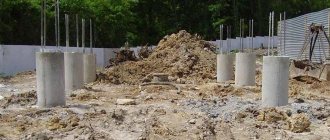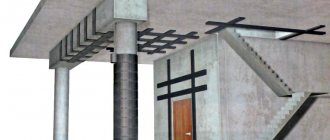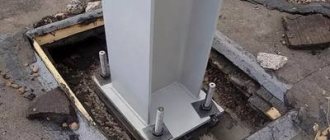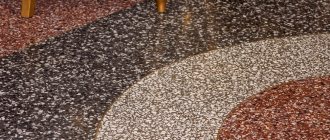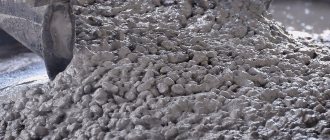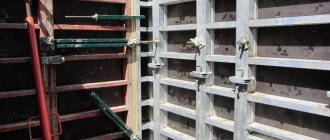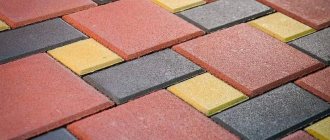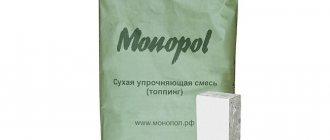Features of well cement
The solution for grouting work is prepared from cement with specific properties. Material:
- has a fine grind;
- hardens in a short time, while the mixture of cement and water remains fluid for a long time, which allows it to be pumped freely;
- sets and hardens despite contact with water;
- compatible with a variety of additives.
The monolithic structure, made of cement mortar, maintains its integrity for many years and does not lose strength due to its resistance to environmental influences, including aggressive ones.
Combined polymer-cement mortars
Combined solutions are obtained by combining a cement suspension and a solution of polyacrylamide or hypane in a cement slurry. To prepare the combined mixture, the following proportion of components is used:
- ¾ cement cement;
- ¾ water in a ratio of 60% by weight of dry cement;
- ¾ calcium chloride (2.5-5%);
- ¾ polyacrylamide (0.15-0.20%).
Due to its high viscosity, polyacrylamide is pre-diluted to a concentration of three percent solution and introduced into the cement mass directly in the drill pipes to avoid premature setting.
Composition
The basis for the production of well cement is crushed clinker (from 80%) and gypsum (2-3.5%). Various minerals are added to them to prepare working mixtures with desired properties. Several types of cement mortars are used:
- Hygroscopic. The additive is triethanolamine.
- Sandy. Gypsum and quartz sand are added to the main composition.
- Weighted. Weighting additives include iron ore minerals (magnetite, hematite, sleeper).
- Salt resistant. Finely ground quartz sand added to the solution creates a material that protects pipes from corrosion caused by groundwater with a high salt content.
Special cement Portland cements include a sulfate-resistant mixture that is resistant to aggressive environments.
In difficult geological conditions, including if there are layers in the section that are absorbent or prone to hydraulic fracturing, deep wells are cemented using lightweight solutions. Lightweight oil well cement is made by introducing additives that reduce the density of the composition - ash, tripoli, diatomite, aluminosilicate microspheres, etc.
The density of light cement cements intended for work at great depths and for repairing damaged areas of the shell is even lower. Such materials are easier to pump, they have high adhesion and adhere well to the old cement shell of the pipe, and are able to fill voids and cracks. Additives include kaolin, hollow aluminosilicate microspheres, etc.
Difference between cement and expansion cement. When cementing wells in porous and loose rocks, it is necessary to create a shell of cement stone that is not prone to shrinkage.
Expanding cement contains additives, due to which chemical reactions occur in the cement mortar to form crystalline products. Thus, the solution increases in volume during the hardening process, and the resulting stone has a dense structure. Conventional cement cements do not expand during hardening.
Portland cement is the basis of cement rinsing solution
Portland cement and blast furnace slag are used as the cementing component of flushing cement slurries.
Portland cement is a bulk material with astringent properties obtained by simultaneously grinding gypsum, clinker and (or) granulated blast furnace slag. In this case, the amount of gypsum in the resulting mixture is regulated within 1.5-3.5%. Portland cement cement mixtures have the ability to harden and transform into a mineral compound characterized by increased mechanical strength some time after diluting the components in water. Cement stone is formed as a result of reactions of hydration and hydrolytic dissociation of clinker elements (calcium aluminates, aluminoferrites, silicates). Thus, it is the mineral composition of the clinker that plays the main role in the occurrence of chemical reactions that determine the rate of hardening of the rinsing cement mortar and the finishing functional properties of the resulting concrete.
In fields with high pressure (abnormally high pressure), well cementing work is carried out using a multi-stage method, while the density of the drilling cementing fluid is increased to the maximum possible value. In addition to these technological methods, in order to avoid behind-the-casing oil, gas and water shows, sedimentation-resistant cementing components are used, which ensure accelerated “setting” of the cement mixture. As a result of treatment, the well walls successfully resist formation permeability.
Marking of well cement
Well cement is produced in accordance with GOST 1581-96. The material is marked PTC (Portland cement). Depending on the characteristics and properties, well cement is:
- Without additives (I, IG, IH), with the addition of minerals (II), with impurities that regulate the density of the composition (III).
- Weighted (Ut), lightened (Ob);
- For use at low and normal (15-50°C), moderate (51-100°C) and elevated (101-150°C) temperatures;
- Regular and sulfate-resistant (SS).
The standard marking indicates the type of cement, its sulfate resistance, average density, maximum permissible temperature of use, degree of plasticization (PL) or hydrofication (HF), and GOST number.
Performance characteristics depend on the brand of well cement and the characteristics of its manufacture. The table below shows the limits within which material performance may vary.
| Name of indicator, unit of measurement | Possible range, numerical value |
| Compressive strength after 8 hours, MPa | When hardening at a temperature of 38°C – 2.1 60°C – 10.3 |
| Bending strength, MPa | From 0.7 to 3.5 depending on the brand of PC |
| Grinding fineness: Residue on sieve with mesh No. 008, %, no more Specific surface, m2/kg | 10-15 230-270 |
| Water separation, ml, no more | 7,5-10 |
| Dough spreadability, mm, not less | For unplasticized – 200 PL – 220 |
| Thickening time to consistency 30, min. | From 90 |
These characteristics of oil well cement are given in the product certificate along with information about the date of manufacture and volume of the batch of material.
Main technical characteristics
The properties of Portland cement cement are strictly regulated by the state standard, which must be followed by producers of the cementitious mixture.
The main technical indicators of TP according to GOST 26798.1-96 are:
- Specific bulk density - 800 -1200 kg/m.
- Bulk surface - 250-1500 m2/kg (depending on the fineness of grinding, the mineralogical composition of the solution and additives included in the solution).
- Mobility is about 18-25 cm at w/c = 0.5. The lower level is 16 cm, when the mixture remains plastic.
- Water content - 0.35 -0.4 (practically). Theoretically - 0.2 - 0.25. To obtain a plastic solution, you need to achieve 18 cm of spreading of the material along the AzNII-cone. This means that for each batch of cement and mortar, the amount of liquid is greater than normal.
- Setting time at the initial stage is no earlier than 1 hour 45 minutes. Completion of hardening - no later than 10 hours.
- Strength - 27-62 kg/cm2.
- Shrinkage is not allowed.
- Water separation - no more than 7.5-10 ml.
The specified technical characteristics must be contained in the certificate along with information about the batch and date of manufacture.
Like the ordinary one, the cementing one retains all its properties for 6 months. The activity of the solution is lost upon interaction with moisture and contact with open air. The hardening time after mixing with liquid depends on the temperature in the well, the amount of sodium chlorine, potassium chloride in the mixture. If the temperature is above 60°C, the range ranges from 10 minutes to 10 hours. If lower - from 2 to 12 hours.
Areas of application
The use of well cement is due to its main quality: the material has high strength indicators from the very beginning of hardening. This type of cement is primarily intended for plugging oil and gas wells. During the cementing process, the drilling mixture is simultaneously displaced.
Well cement for wells is pumped using pumping equipment - to ensure fluidity of the solution, the volume of water must be twice the volume of dry components. The resulting mass (pulp) is characterized by high mobility; after hardening, it forms a dense monolith, not prone to shrinkage, between the casing pipe and the walls of the well. In this case, the material is tightly adhered to both the pipe and the walls of the shaft drilled into the rocks.
The cement shell serves to protect the casing from shifts of layers, from contact with groundwater, and aggressive gaseous media. Well cement is used to strengthen the bottom of the well and reduce its depth, to eliminate damage to the casing itself.
This type of cement is practically not used in construction. An exception is the use of cement cement for the foundation of drilled piles, which are installed on difficult soils.
Additives that improve the properties of cement slurries
To improve the performance characteristics of the flushing cement slurry, the following additives are used:
- calcium chloride and sodium carbonate. Used to reduce the setting time of concrete. Adding accelerators to water or dry components makes it possible to obtain fast-setting mixtures (fast-setting mixtures), which are used at well temperatures ranging up to 50-65°C. FBS with expansion properties is obtained by adding up to 10-30% gypsum-alumina cement to the feedstock. FBS based on pozzolanic cements are characterized by low density and a high threshold for thickening intensity;
- gypsum. The addition of gypsum makes it possible to shorten the hardening time, resulting in a high-strength stone obtained within 3-4 hours after pumping the washing cement solution. To prevent the setting process from starting in the drill pipes, process retardants are specially added to them. Gypsum-cement cement slurries are much more resistant to dilution with water than conventional cement slurries and are used in the presence of water layers;
- bentonite, the use of which increases the starting mobility of the flushing cement slurry, which optimizes the injection work, especially when it is necessary to use a high density of cementing material. Clay-cement mixtures provide stable viscosity of the working material during its pressing into the absorption zone, after which a sharp increase in the parameter occurs and the onset of a period of plastic strength. To improve the characteristics of bentonite mixtures and level out the effects of formation waters before hardening begins, it is possible to add sodium or potassium silicate to the solution in an amount of 3-10% by weight of cement;
- cement-resin composition (CSK) using plasticizer TEG-1 (epoxy aliphatic resin). The resin is a viscous yellow liquid that can dissolve in water. Used when there is a well complication in the form of nearby aquifers;
- hydrocarbon additives (diesel fuel added in an amount of 30%). Solar-cement mixtures are used when it is necessary to pump the solution to great depths. The cement component is inert to hydrocarbons and the solution acquires viscosity and plastic strength only after replacing diesel fuel with water. To enhance the strength of concrete and reduce material costs, it is allowed to add up to 50% quartz sand to the mass.
A common disadvantage of almost all cement mixtures is the low corrosion resistance of the resulting cement stone, its shrinkage during further operation and the possibility of water penetration through the pores.
Construction of the cement layer
When constructing a shallow foundation in the event of a large influx of groundwater in the pit, it is necessary to lay a grouting layer of concrete under the foundation (Fig. 2.8).
The technology for laying the backfill concrete layer using the vertically moved pipe (VPT) method is as follows:
- on scaffolding (placed, for example, on a fence), concrete pipes are installed, consisting of links 3–4 m long, which are connected by flange joints; in the upper part of the pipe there are funnels, each with a capacity of 1.2–1.5 m;
- a plug is placed in the neck of the funnel (for example, from burlap filled with tow), attached with wire to the top of the funnel;
- the concrete pipe is lowered with its lower end into water at the bottom of the pit;
- a portion of cast concrete mixture with a cone draft of 16–18 cm is supplied to the receiving hopper, completely filling the hopper;
- the wire connecting the plug to the top of the funnel is cut off. The mass of concrete mixture, displacing water, rushes down the pipe. If the concrete casting pipe is long, simultaneously with the opening of the damper in the neck of the bunker above the funnel, a bucket of concrete mixture is opened. Otherwise, squeezing water out of the pipe may not occur;
- if the concrete mixture does not reach the required level, the pipe is lifted slightly with a crane and immediately dropped to the bottom of the pit;
- a new portion of concrete mixture is supplied to the receiving hopper.
As concreting proceeds, the cast concrete mixture gradually spreads over the pit. Only the top layer of concrete comes into contact with water, because the concrete mixture is fed into the previously laid volume. After pumping water from the pit, the weak top layer of concrete must be removed. In the process of laying concrete using the VPT method, the concrete pipe, after loading portions of the concrete mixture into it, is slightly pulled up and quickly settled. This is done in order to ensure in any case that the pipe is buried in the concrete mixture by no less than 0.8 m and no more than 2 m. The master is obliged to continuously take measurements of the concrete level and control whether the end of the pipe is sufficiently immersed in the concrete layer.
Rice. 2.8 – Underwater concreting using the VPT method: a – general diagram; b – work order; 1 – concrete pipe; 2 – funnel; 3 – underwater concrete; 4 – valve; 5 – plug
To concrete a waterproof cushion in a pit, several concrete-casting pipes are used, which are placed so that the areas of the areas they serve overlap the area being concreted and overlap one another.
The radius of action of the concrete pipe R, m, is determined from the expression
R = 6KI,
where K is an indicator of maintaining the mobility of the concrete mixture, is the time during which the cone settlement decreases to 0.15 m (K = 0.65 hours);
I – concreting intensity, accepted for pits of at least 0.3 m3/m2h (it is desirable that this value be 1–1.2 m3/m2h, then R = 3–4.5 m).
Concreting begins with one of the pipes located at the edge of the pit. The next pipe is put into operation after the concrete mixture, spreading over the pit area, covers the lower end of the pipe by 30–40 cm. When concreting with several pipes, the concrete mixture is laid sequentially. The distance between adjacent pipes should not exceed 0.7 of the radius of the pipe.
When carrying out underwater concreting, water should not be allowed to break through into the pipe. If this happens, the concreting process must be stopped. It can be resumed immediately if the break did not exceed the time for maintaining the mobility of the concrete mixture. If this time is exceeded, concreting can be continued only after the underwater concrete reaches a strength of 2–2.5 MPa,
When laying a cast concrete mixture, underwater concrete of low strength is obtained (if the cement consumption is 400 kg/m3, the concrete will have a strength of only 10–15 MPa).
When there is a need to obtain underwater concrete of higher strength, it is necessary to sharply increase the cement consumption to 600 kg/m3 and increase the rigidity of the concrete mixture. But the rigid concrete mixture does not spread well over the pit, so vibration must be used when laying it. To obtain rigid concrete mixtures with a cone draft of 6–10 cm, one vibrator (vibrating head) or two if the pipe length exceeds 20 m is rigidly attached to the end (lower) link of a pipe up to 20 m long. Vibration facilitates the passage of the mixture through the pipe and its spreading along pit area. The maximum radius of spread of a rigid concrete mixture during underwater concreting with vibration is 3 m. A forced break in concreting should not exceed 1.5 hours.
The minimum thickness of the backfill concrete layer laid on the soil bottom is determined by calculation from the condition (hbabγb + G = hwγwab) - equality of the weight of the cushion and the hydrostatic buoyancy effect of water (with a safety factor of 1.1), but not less than 1.5 m. Drainage from the pit is permitted only after the underwater concrete has reached a strength of at least 5 MPa. The underwater mass constructed by the VPT method should be brought to a level 10 cm higher than the design level so that it is possible to remove the upper weak layer of concrete after pumping out water from the pit.
vse-lekcii.ru
